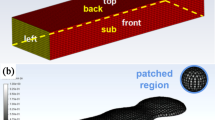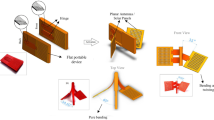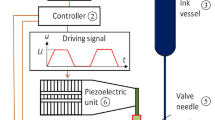Abstract
Inkjet 3D printing using array nozzles allows efficient deposition of complex shapes on free-form surfaces. However, the slip of droplets on curved substrates and the flow of printing materials can cause edge collapse and poor surface morphology of curved multilayer printed parts. In this study, a part morphology prediction model for curved inkjet 3D printing is developed to predict the surface morphology of printed parts. First, from the perspective of computational fluid dynamics, a surface drop prediction model is formed to predict the slip and deposition patterns of ink droplets on curved substrates. The model calculates the spreading diameter of droplets and slip distance on curved surfaces based on the physical parameters of droplets, substrate roughness, and droplet impact angle. Then, based on the droplet slip distance and spreading diameter data obtained from the droplet drop prediction model, a multilayer stacking model for surface printing is established to predict the evolution of part height and contour shape in printing. After discretizing the print area, the morphology prediction of curved inkjet 3D printed parts is achieved by analytically modeling the physical processes such as droplet deposition, local ink flow, and solvent volatilization. Finally, multilayer printing experiments on a spherical surface are conducted to verify the accuracy of the prediction model. The results show that the predicted shape of the sample parts is in good agreement with the experimental results. The model provides a theoretical basis for the closed-loop control of surface inkjet 3D printing and printing defect compensation.








Similar content being viewed by others
References
Kawale SS, Jang I, Farandos NM, Kelsall GH (2022) Inkjet 3D-printing of functional layers of solid oxide electrochemical reactors: a review. React Chem Eng 7:1692–1712. https://doi.org/10.1039/D1RE00454A
Farandos NM, Jang I, Alexander JC, Kelsall GH (2022) 3-D inkjet printed solid oxide electrochemical reactors III. Cylindrical pillared electrode microstructures. Electrochim Acta 426:140834. https://doi.org/10.1016/j.electacta.2022.140834
Sui Y, Zorman CA (2020) Review—inkjet printing of metal structures for electrochemical sensor applications. J Electrochem Soc 167:037571. https://doi.org/10.1149/1945-7111/ab721f
Ly M, Spinelli S, Hays S, Zhu D (2022) 3D printing of ceramic biomaterials. Eng Educ Regen 3:41–52. https://doi.org/10.1016/j.engreg.2022.01.006
Rich SI, Lee S, Fukuda K, Someya T (2022) Developing the nondevelopable: creating curved-surface electronics from nonstretchable devices. Adv Mater 34:e2106683. https://doi.org/10.1002/adma.202106683
Sui X, Downing JR, Hersam MC, Chen J (2021) Additive manufacturing and applications of nanomaterial-based sensors. Mater Today 48:135–154. https://doi.org/10.1016/j.mattod.2021.02.001
Rich SI, Jiang Z, Fukuda K, Someya T (2021) Well-rounded devices: the fabrication of electronics on curved surfaces–a review. Mater Horiz 8:1926–1958. https://doi.org/10.1039/d1mh00143d
Han X, Li J, Tang X, Li W, Zhao H, Yang L, Wang L (2022) Droplet bouncing: fundamentals, regulations, and applications. Small 18:e2200277. https://doi.org/10.1002/smll.202200277
Srivastava T, Jena SK, Kondaraju S (2021) Droplet impact and spreading on inclined surfaces. Langmuir 37:13737–13745. https://doi.org/10.1021/acs.langmuir.1c02457
Du J, Zhang Y, Min Q (2021) Numerical investigations of the spreading and retraction dynamics of viscous droplets impact on solid surfaces. Colloids Surf A Physicochem Eng Aspects 609:125649. https://doi.org/10.1016/j.colsurfa.2020.125649
Xiao J, Pan F, Xia H, Zou S, Zhang H, George OA, Zhou F, Huang Y (2018) Computational study of single droplet deposition on randomly rough surfaces: surface morphological effect on droplet impact dynamics. Ind Eng Chem Res 57:7664–7675. https://doi.org/10.1021/acs.iecr.8b00418
Wang L, Feng J, Dang T, Peng X (2021) Dynamics of oil droplet impacting and wetting on the inclined surfaces with different roughness. Int J Multiphase Flow 135:103501. https://doi.org/10.1016/j.ijmultiphaseflow.2020.103501
Comminal R, Serdeczny MP, Pedersen DB, Spangenberg J (2018) Numerical modeling of the strand deposition flow in extrusion-based additive manufacturing. Addit Manuf 20:68–76. https://doi.org/10.1016/j.addma.2017.12.013
Xia Huanxiong Lu, Jiacai DS, Tryggvason G (2018) Fully resolved numerical simulations of fused deposition modeling. part i: fluid flow. Rapid Prototyp J 24:463–476. https://doi.org/10.1108/RPJ-12-2016-0217
Knapp GL, Mukherjee T, Zuback JS, Wei HL, Palmer TA, De A, DebRoy T (2017) Building blocks for a digital twin of additive manufacturing. Acta Mater 135:390–399. https://doi.org/10.1016/j.actamat.2017.06.039
Guo Y, Mishra S (2016) A predictive control algorithm for layer-to-layer ink-jet 3D printing. In: 2016 American Control Conference (ACC), Boston, MA, USA, pp 833–838. https://doi.org/10.1109/ACC.2016.7525017
Guo Y, Peters J, Oomen T, Mishra S (2017) Distributed model predictive control for ink-jet 3D printing. In: 2017 IEEE International Conference on Advanced Intelligent Mechatronics (AIM), Munich, Germany, pp 436–441. https://doi.org/10.1109/AIM.2017.8014056
Guo Y, Peters J, Oomen T, Mishra S (2018) Control-oriented models for ink-jet 3D printing. Mechatronics 56:211–219. https://doi.org/10.1016/j.mechatronics.2018.04.002
Lu L, Zheng J, Mishra S (2014) A model-based layer-to-layer control algorithm for ink-jet 3d printing. In: ASME 2014 Dynamic Systems and Control Conference(DSCC), San Antonio, Texas, USA, V002T35A001. https://doi.org/10.1115/DSCC2014-5914
Lu L, Zheng J, Mishra S (2015) A layer-to-layer model and feedback control of ink-jet 3-d printing. IEEE ASME Trans Mechatron 20:1056–1068. https://doi.org/10.1109/TMECH.2014.2366123
Wu Y, Chiu G (2019) Modeling height profile for drop-on-demand print of UV curable ink. In: Proceedings of the ASME 2019 Dynamic Systems and Control Conference, Park City, Utah, USA, V002T13A006. https://doi.org/10.1115/DSCC2019-9242
Wu Y, Chiu G (2021) An improved model of height profile for drop-on-demand print of ultraviolet curable ink. Control 1:031010. https://doi.org/10.1115/1.4050012
Wu Y, Chiu G (2021) An improved height difference based model of height profile for drop-on-demand 3D printing with UV curable ink. In: 2021 American Control Conference (ACC), New Orleans, LA, USA, pp 491–495. https://doi.org/10.23919/ACC50511.2021.9483241
Funding
This work was supported by the National Natural Science Foundation of China [Grant 52035010], Shaanxi Key Industry Chain Project [grant number 2020ZDLGY14-08], Shaanxi Innovation Team Project [grant number 2018TD-012], National 111 Project [grant number B14042], National Natural Science Foundation of China [grant number 52205411], Shaanxi Province Science and Technology Project Youth Fund [grant number 2022JQ-366], and National Defense Science and Technology Key Laboratory Fund [grant number 2022-JCJQ-LB-018].
Author information
Authors and Affiliations
Contributions
Bu Ping: methodology, writing—original draft, software, visualization. Jin Huang: conceptualization, writing—review and editing, resources, supervision. Fanbo Meng: conceptualization, writing—review and editing, supervision.
Corresponding authors
Ethics declarations
Competing interests
The authors declare no competing interests.
Additional information
Publisher's note
Springer Nature remains neutral with regard to jurisdictional claims in published maps and institutional affiliations.
Supplementary information
Below is the link to the electronic supplementary material.
Rights and permissions
Springer Nature or its licensor (e.g. a society or other partner) holds exclusive rights to this article under a publishing agreement with the author(s) or other rightsholder(s); author self-archiving of the accepted manuscript version of this article is solely governed by the terms of such publishing agreement and applicable law.
About this article
Cite this article
Ping, B., Huang, J. & Meng, F. Prediction model of part topography in curved surface inkjet 3D printing. Int J Adv Manuf Technol 127, 3371–3384 (2023). https://doi.org/10.1007/s00170-023-11736-z
Received:
Accepted:
Published:
Issue Date:
DOI: https://doi.org/10.1007/s00170-023-11736-z




